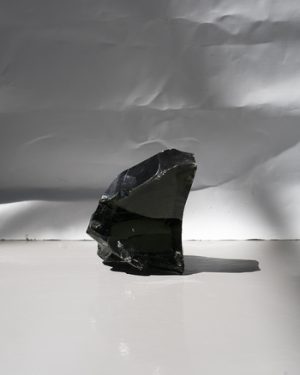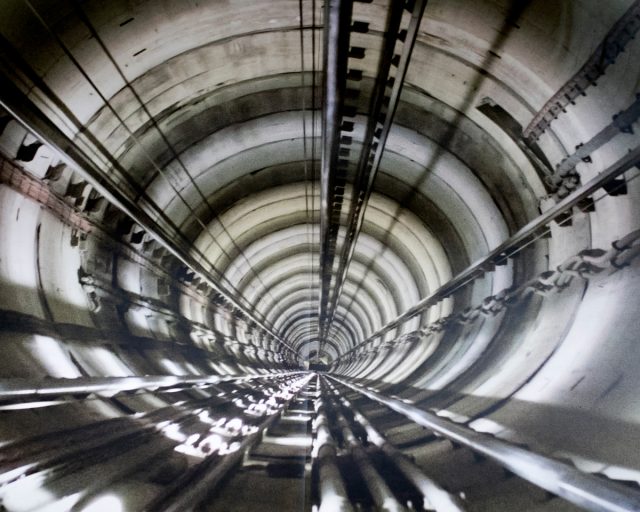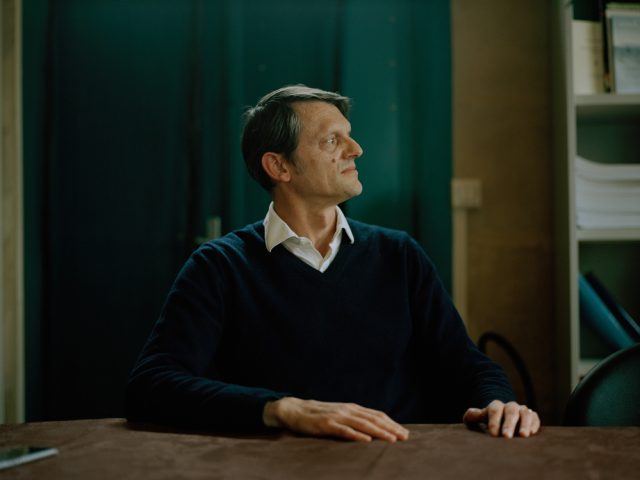In January 1997, the crew of a fishing vessel in the Baltic Sea found something unusual in their nets: a greasy yellowish-brown lump of clay-like material. They pulled it out, placed it on deck and returned to processing their catch. The next day, the crew fell ill with serious skin burns. Four were hospitalized. The greasy lump was a substance called yperite, better known as sulfur mustard or mustard gas, solidified by the temperature on the sea bed.
At the end of the World War II, the US, British, French and Soviet authorities faced a big problem—how to get rid of some 300,000 tonnes of chemical munitions recovered from occupied Germany. Often, they opted for what seemed the safest, cheapest and easiest method: dumping the stuff out at sea.

Estimates are that at least 40,000 tonnes of chemical munitions were disposed of in the Baltic Sea, not all of it in designated dumping areas. Some of these locations are marked on shipping charts but comprehensive records of exactly what was dumped and where do not exist. This increases the likelihood of trawler crews, and others, coming into contact with this dangerous waste.
The problem isnt going to go away, especially with increased use of the sea floor for economic purposes, including pipelines, sea cables and offshore windfarms.
The story of those unlucky fishermen illustrates two points. First, it is difficult to predict how future generations will behave, what they will value and where they will want to go. Second, creating, maintaining and transmitting records of where waste is dumped will be essential in helping future generations protect themselves from the decisions we make today. Decisions that include how to dispose of some of todays most hazardous material: high-level radioactive waste from nuclear power plants.
Down, down
The red metal lift takes seven juddering minutes to travel nearly 500 meters down. Down, down through creamy limestone to reach a 160-million-year-old layer of clay. Here, deep beneath the sleepy fields and quiet woods along the border of the Meuse and Haute-Marne departments in north-east France, the French National Radioactive Waste Management Agency (Andra) has built its underground research laboratory.
The laboratorys tunnels are brightly lit but mostly deserted, the air dry and dusty and filled with the hum of a ventilation unit. Blue and grey metal boxes house a series of ongoing experiments—measuring, for example, the corrosion rates of steel, the durability of concrete in contact with the clay. Using this information, Andra wants to build an immense network of tunnels here.
It plans to call this place Cigéo, and to fill it with dangerous radioactive waste. It is designed to be able to hold 80,000 cubic meters of waste.

We are exposed to radiation every day. Public Health England estimates that in a typical year someone in the UK might receive an average dose of 2.7 millisieverts (mSv) from natural and artificial radiation sources. A transatlantic flight, for example, exposes you to 0.08 mSv; a dental X-ray to 0.005 mSv; 100 grams of Brazil nuts to 0.01 mSv.
High-level radioactive waste is different. It is, primarily, spent fuel from nuclear reactors or the residues resulting from reprocessing that fuel. This waste is so potent that it must be isolated from humans until its levels of radiation, which decrease over time, are no longer hazardous. The timescale Andra is looking at is up to one million years. (To put this into some sort of context, its just 4,500 years ago that Stonehenge was constructed. Around 40,000 years ago, modern humans arrived in northern Europe. A million years ago, the continent was in the middle of an Ice Age. Mammoths roamed the frozen landscape.)
Some scientists call this long-lived waste “the Achilles heel of nuclear power”, and its a problem for all of us—whatever our stance on nuclear. Even if all the worlds nuclear plants were to cease operating tomorrow, we would still have more than 240,000 tonnes of dangerously radioactive material to deal with.

Currently, nuclear waste is stored above ground or near the surface, but within the industry this is not considered an acceptable long-term solution. This kind of storage facility requires active monitoring. As well as regular refurbishment it must be protected from all kinds of hazards, including earthquakes, fires, floods and deliberate attacks by terrorists or enemy powers.
This not only places an unfair financial burden on our descendants, who may no longer even use nuclear power, but also assumes that in the future there will always be people with the knowledge and will to monitor the waste. On a million-year timescale this cannot be guaranteed.
So, after considering a range of options, governments and the nuclear industry have come to the view that deep, geological repositories are the best long-term approach. Building one of these is an enormous task that comes with a host of complex safety concerns.
Finland has already begun construction of a geological repository (called Onkalo), and Sweden has begun the licensing process for its site. Andra expects to apply for its construction licence within the next two years.
If Cigéo goes into operation it will house both the high-level waste and what is known as intermediate-level long-lived waste—such as reactor components. Once the repository has reached capacity, in perhaps 150 years time, the access tunnels will be backfilled and sealed up. If all goes according to plan, no one will ever enter the repository again.

Radiation
Stand in front of an unshielded source of radiation and you wont see or feel anything. However, some of that radiation will be passing into your body. Nuclear waste is dangerous because it emits ionising radiation in the form of alpha and beta particles and gamma rays. While alpha particles are too weak to penetrate the skin, beta particles can cause burns. If ingested, both can damage internal tissues and organs.
Its gamma rays, however, that have the greatest penetrating range, and therefore the potential to cause the most widespread damage to the DNA of your cells. This damage may lead to an increased risk of cancer later in life, and it is largely responsible for the set of symptoms known as radiation sickness.
Some experts estimate that a dose of over 1 sievert is enough to cause radiation sickness. Symptoms include nausea, vomiting, blisters and ulcers; these may begin within minutes of exposure or be delayed for days. Recovery is possible, but the higher the radiation dose, the less likely it is. Typically, death comes from infections and internal bleeding brought about by the destruction of the bone marrow.
For waste buried deep underground, the major threat to public health comes from water contamination. If radioactive material from the waste were to mix with flowing water, it would be able to move relatively swiftly through the bedrock and into the soil and large bodies of water such as lakes and rivers, finally entering the food chain via plants, fish and other animals.
To prevent this, an underground repository such as Cigéo will take great care to shield the waste it stores. Within its walls there will be metal or concrete containers to block the radiation, and liquid waste can be mixed into a molten glass paste that will harden around it to stop leakage.
Beyond those barriers, the planners choose their sites carefully, so they can exploit the properties of the surrounding rock. At Cigéo, press officer Mathieu Saint-Louis tells me, the clay is stable and has very low permeability, making it hard for any radioactive material reach the surface. After around 100,000 years a few very mobile substances with a long half-life, such as iodine-129, might manage to migrate upwards in extremely small quantities, but at that point, Saint-Louis says, the “potential impact on humans and the environment is much lower than that of radioactivity that is naturally present in the environment”.
Deep geological repositories are designed as passive systems, meaning that once Cigéo is closed, no further maintenance or monitoring is required. Much more difficult to plan for is the risk of human intrusion, whether inadvertent or deliberate.
Save the knowledge
In 1980, the US Department of Energy created the Human Interference Task Force to investigate the problem of human intrusion into waste repositories. What was the best way to prevent people many thousands of years in the future from entering a repository and either coming into direct contact with the waste or damaging the repository, leading to environmental contamination?
Over the next 15 years a wide variety of experts were involved in this and subsequent projects, including materials scientists, anthropologists, architects, archaeologists, philosophers and semioticians—social scientists who study signs, symbols and their use or interpretation.
Science fiction author Stanislaw Lem suggested growing plants with warning messages about the repository encoded in their DNA. Biologist Françoise Bastide and semiotician Paolo Fabbri developed what they called the “ray cat solution”—cats genetically altered to glow when in the presence of radiation.
Quite apart from the technological challenges and ethical issues these solutions present, both have one major drawback: to be successful they rely on external, uncontrollable factors. How could the knowledge required to interpret these things be guaranteed to last?
Semiotician Thomas Sebeok recommended the creation of a so-called Atomic Priesthood. Members of the priesthood would preserve information about the waste repositories and hand it on to newly initiated members, ensuring a transfer of knowledge through the generations.
Considered one way, this is not too different from our current system of atomic science, where a senior scientist passes on their knowledge to a PhD candidate. But still, putting such knowledge, and therefore power, into the hands of one small, elite group of people is a high-risk strategy easily open to abuse.
Perhaps a better way to warn our descendants about the waste is to talk to them directly, in the form of a message.
At Andras headquarters outside of Paris, Jean-Noël Dumont, head of Andras memory program, shows me a box. Inside, fixed in plastic cases, are two transparent discs, each around 20 centimeters in diameter. “These are the sapphire discs,” he says. The brainchild of Dumonts predecessor, Patrick Charton, each disc is made of transparent industrial sapphire, inside which information is engraved using platinum.
Costing around 25,000 euros per disc, the sapphire (chosen for its durability and resistance to weathering and scratching) could last for nearly 2 million years—though one disc already has a crack in it, the result of a clumsy visitor on one of Andras open days.
In the very long term, though, these plans also have a major drawback: how can we know that anyone living one million years in the future will understand any of the languages spoken today?

Think of the differences between modern and Old English. Who of us can understand “Ðunor cymð of hætan & of wætan”? (Thunder comes from heat and from moisture.) That—meaning “Thunder comes from heat and from moisture”—is a mere thousand years old.
Languages also have a habit of disappearing. Around 4,000 years ago in the Indus Valley in what is now Pakistan and north-west India, for example, people were writing in a script that remains completely indecipherable to modern researchers. In one million years it is unlikely that any language spoken today will still exist.
In the early 1990s, architectural theorist Michael Brill sought a way to side-step the issue of language. He imagined deterrent landscapes, “non-natural, ominous, and repulsive”, constructed of giant, menacing earthworks in the shape of jagged lightning bolts or other shapes that “suggest danger to the body… wounding forms, like thorns and spikes”.
Anyone venturing further into the complex would then discover a series of standing stones with warning information about the radioactive waste written in seven different languages—but even if these proved unreadable, the landscape itself should act as a warning. To help convey a sense of danger there would be carvings of human faces expressing horror and terror. One idea was to base them on Edvard Munchs The Scream.
The drawback is that such a landscape—a strange, disturbing wonder—would probably attract rather than repel visitors. “We are adventurers. We are drawn to conquer forbidding environments,” says Florian Blanquer, a semiotician hired by Andra. “Think about Antarctica, Mount Everest.”
Or think about the 20th-century European archaeologists, people not noticeably hesitant when it came to opening up the tombs of Egyptian kings, despite the warnings and curses inscribed on their walls.
Memory
As Dumont sees it, a memory program is necessary for three main reasons. First, to avoid the risk of human intrusion by informing future generations about the existence and contents of Cigéo.
Second, to give future generations as much information as possible to allow them to make their own decisions about the waste. They might, for example, want to retrieve the waste because new uses or solutions have arisen. Gerry Thomas, chair in molecular pathology at Imperial College London, believes that much of the waste destined for repositories may one day provide an important new non-carbon fuel source.
Third, cultural heritage: a properly documented geological repository would provide a wealth of information for a future archaeologist. “I have no knowledge of other places or systems where you have at the same time objects from the past and very large, concrete descriptions of how these products were manufactured, where they come from, how we considered them and so on,” says Dumont.
One way that memory is transmitted is orally, from generation to generation. To study this, Dumont asked researchers to consider historical examples of oral transmission, using as a case study the 17th-century Canal du Midi between the Mediterranean and Atlantic Ocean. Here, for 300 years, the same families have worked on maintaining the canal, passing down know-how from father to son.
Dumont also talks about the need to ensure that as many people as possible hear about Cigéo. As part of this strategy, Andra has held a series of annual competitions asking artists to suggest ways to mark the site. For example, Les Nouveaux Voisins, winners of the 2016 prize, imagined constructing 80 concrete pillars, 30 meters high, each with an oak tree planted at the top. As the years passed, the pillars would slowly sink and the oak trees replace them, leaving tangible traces both above and below the repository.

Leaving Andras visitors center, I drive through a landscape patchworked with colours, from the russet of the woods to the bright limey green of a wheat field, towards Bure, a tiny village of around 90 inhabitants. The population is ageing.
“Young people cant stay here if they want to study and find jobs,” Benoît Jaquet tells me. A village that once supported around ten farmers is now home to only two or three. Although not a resident of Bure, Jaquet is the general secretary of CLIS, an organisation of local elected officials, representatives from trade unions and professional bodies, and environmental associations. Its purpose is to provide the local community with information about Cigéo, host public meetings, and monitor the work of Andra by, for example, commissioning independent experts to review the agencys work.
If the repository is built, Jaquet says, French law requires that CLIS be transformed into a local commission that will last as long as the repository. “So its also a way to pass the baton,” he says. “If there is a local commission there is a memory—not Andras memory but an external memory.”
At the same time, Andra has set up three regional memory groups, each composed of around 20 interested locals. They meet every six months and make their own suggestions for passing on the memory of the repository. Ideas so far include collecting and preserving oral witness accounts and developing an annual remembrance ceremony to take place on the site, organized by and for the local people. A nuclear beating the bounds, a radioactive summer solstice, an atomic maypole.
This last idea resonates with the work of Claudio Pescatore and Claire Mays, former employees of the Nuclear Energy Agency, a Paris-based body that supports intergovernmental cooperation on nuclear issues. They wrote in a research paper: “Do not hide these facilities; do not keep them apart, but make them A PART of the community… something that belongs to the local, social fabric.” They went on to suggest that a monument celebrating the repository could be created, and argued that if it had “a distinctiveness and aesthetic quality, would this not be one reason for communities to proudly own the site and Read More – Source







